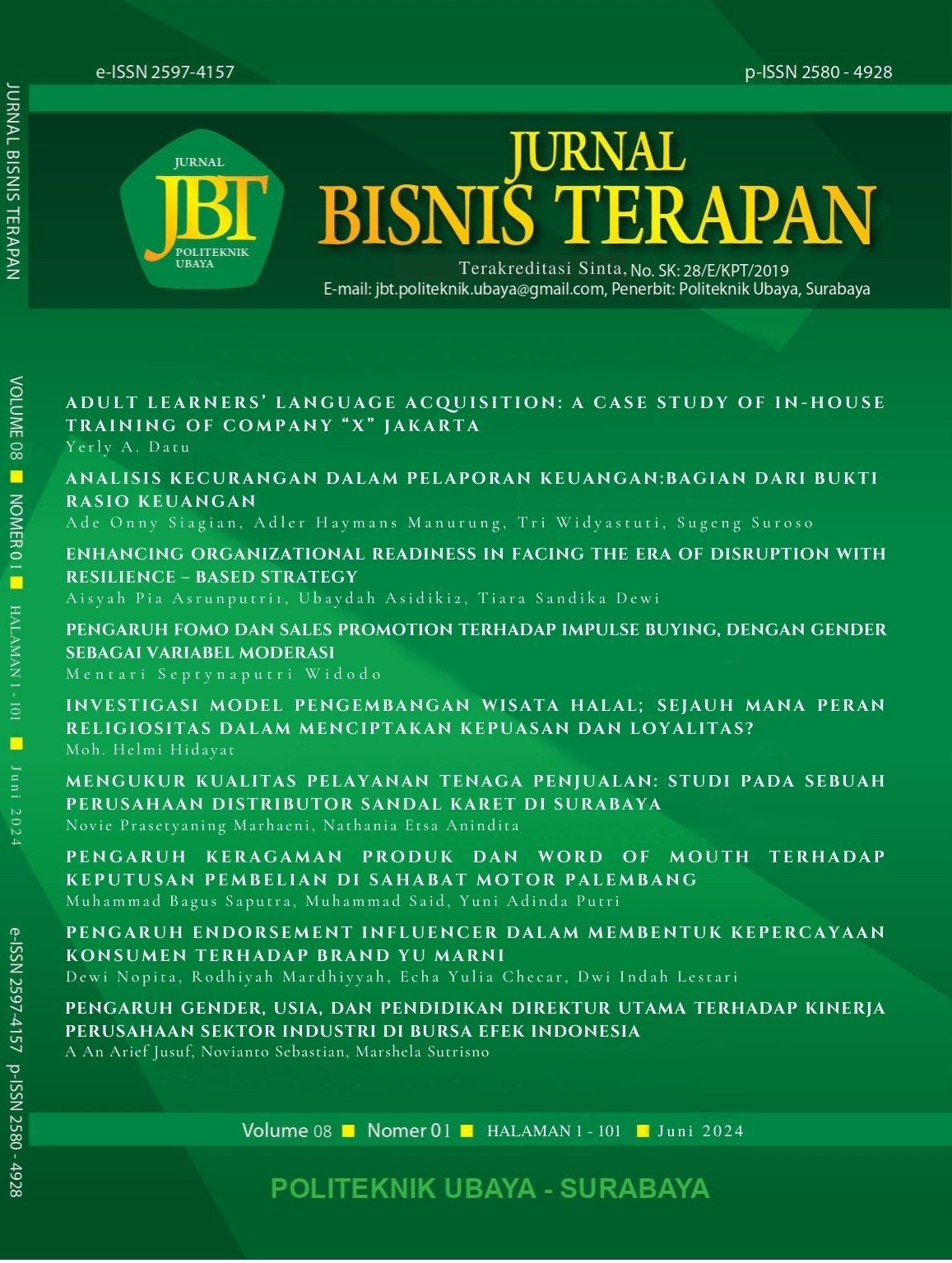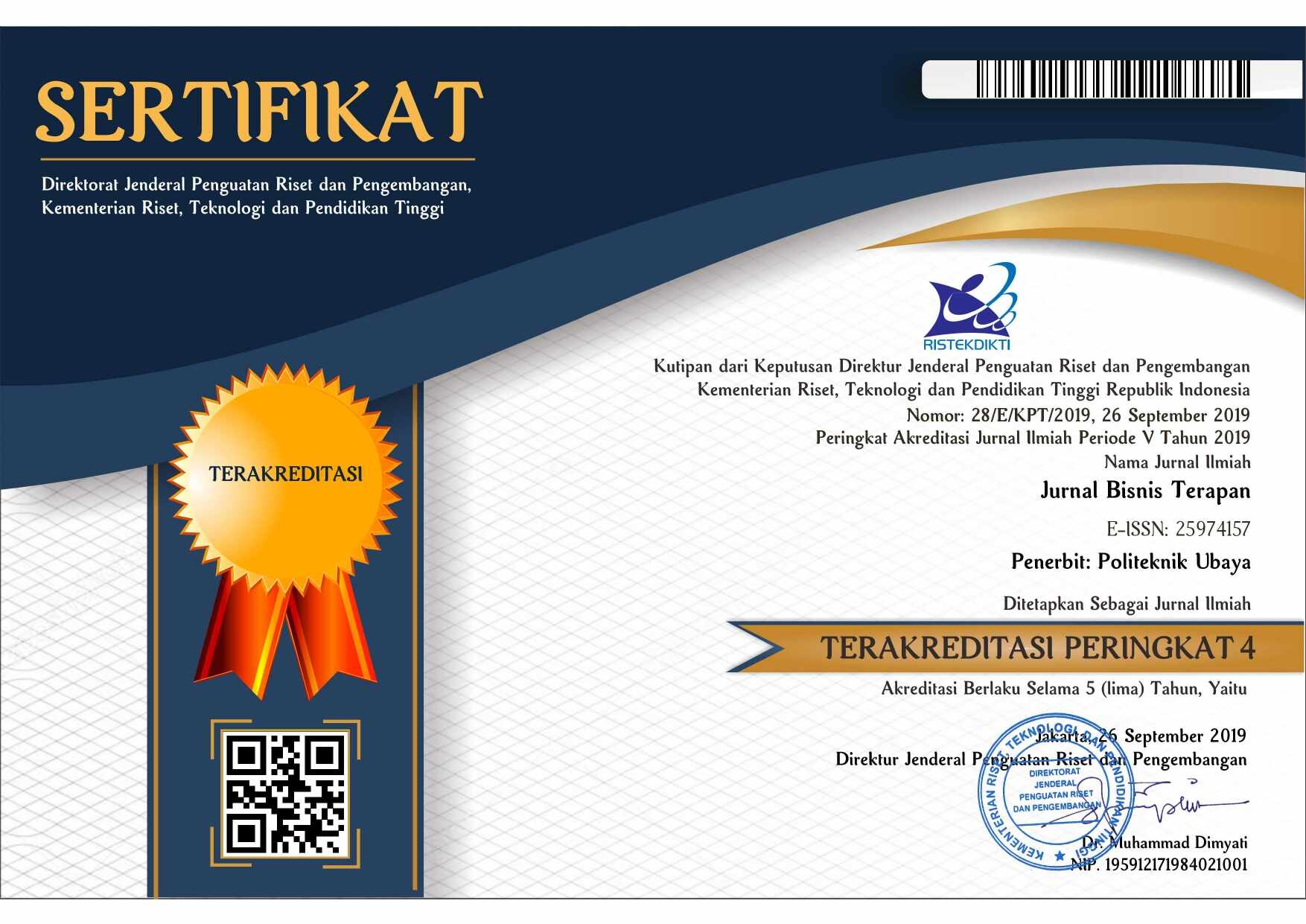INVESTIGASI MODEL PENGEMBANGAN WISATA HALAL; SEJAUH MANA PERAN RELIGIOSITAS DALAM MENCIPTAKAN KEPUASAN DAN LOYALITAS?
 Abstract Views:
196 times
Abstract Views:
196 times
 PDF Downloads:
187 times
PDF Downloads:
187 times
Abstract
Creating satisfaction and loyalty in the tourism business is the basis that will determine the sustainability of the business. These two variables are very important variables, even this issue is being studied among researchers, regarding what factors are the determinants in creating satisfaction and loyalty. This research is in the form of dissecting the determining factors that will create satisfaction and loyalty. This study tries to dissect whether religiosity, destination image, demographics and motivation have a big role in creating satisfaction and loyalty. To do so, researchers managed to collect as many as 177 respondents to fill out a research questionnaire. Then from the data that the researcher has obtained, the researcher analyzes the data statistically descriptive and SEM PLS to prove the hypothesis that has been made by the researcher. From this analysis the researcher got the result that religiosity, destination image, demographics have a positive and significant effect on satisfaction, while motivation is not significant on satisfaction. Besides that, religiosity, destination image, demographics can indirectly influence the loyalty variable through satisfaction. Religiosity can be a moderating variable for the relationship between demographics and satisfaction. Finally, the satisfaction variable has a significant effect on loyalty.
Downloads
References
Abror, A., Wardi, Y., Trinanda, O., & Patrisia, D. (2019). The impact of Halal tourism, customer engagement on satisfaction: moderating effect of religiosity. Asia Pacific Journal of Tourism Research, 24(7), 633–643. https://doi.org/10.1080/10941665.2019.1611609
Bahrudin, M., & Zuhro, S. (2016). Pengaruh Kepercayaan Dan Kepuasan Pelanggan Terhadap Loyalitas Pelanggan. BISNIS : Jurnal Bisnis Dan Manajemen Islam, 3(1), 1. https://doi.org/10.21043/bisnis.v3i1.1463
Battour, M., Rahman, M. K., & Rana, M. S. (2020). The impact of PHTPS on trip quality, trip value, satisfaction and word of mouth: Non-Muslim tourists’ perspective. Journal of Islamic Marketing, 11(6), 1517–1538. https://doi.org/10.1108/JIMA-03-2019-0058
Benitez, J., Henseler, J., Castillo, A., & Schuberth, F. (2020). How to perform and report an impactful analysis using partial least squares: Guidelines for confirmatory and explanatory IS research. Information and Management, 57(2), 103168. https://doi.org/10.1016/j.im.2019.05.003
Chen, Y. F., & Law, R. (2016). A Review of Research on Electronic Word-of-Mouth in Hospitality and Tourism Management. International Journal of Hospitality and Tourism Administration, 17(4), 347–372. https://doi.org/10.1080/15256480.2016.1226150
Chindaprasert, K., Yasothornsrikul, P., & Esichaikul, R. (2015). The Effects of Motivation and Satisfaction on Destination Loyalty at the Thailand -Laos (PDR) Border. Asia-Pacific Journal of Innovation in Hospitality and Tourism (APJIHT), 4(1), 1–17. https://doi.org/10.7603/s40930-015-0001-y
Dean, D., & Suhartanto, D. (2019). The formation of visitor behavioral intention to creative tourism: the role of push–Pull motivation. Asia Pacific Journal of Tourism Research, 0(0), 1–11. https://doi.org/10.1080/10941665.2019.1572631
Eid, R., & El-Gohary, H. (2015). The role of Islamic religiosity on the relationship between perceived value and tourist satisfaction. Tourism Management, 46, 477–488. https://doi.org/10.1016/j.tourman.2014.08.003
El-Gohary, H. (2016). Halal tourism, is it really Halal? Tourism Management Perspectives, 19, 124–130. https://doi.org/10.1016/j.tmp.2015.12.013
Hair, J. F., Hult, G. T. M., Ringle, C. M., & Sarstedt, M. (2017). A Primer on Partial Least Squares Structural Equation Modeling (PLS-SEM) (Second Edi). SAGE Publications.
Hair, J. F., Risher, J. J., Sarstedt, M., & Ringle, C. M. (2019). When to use and how to report the results of PLS-SEM. European Business Review, 31(1), 2–24. https://doi.org/10.1108/EBR-11-2018-0203
Kanwel, S., Lingqiang, Z., Asif, M., Hwang, J., Hussain, A., & Jameel, A. (2019). The influence of destination image on tourist loyalty and intention to visit: Testing a multiple mediation approach. Sustainability (Switzerland), 11(22). https://doi.org/10.3390/su11226401
KNEKS, & IAEI. (2020). Laporan Perkembangan Pariwisata Ramah Muslim Daerah. In Komite Nasional Ekonomi dan Keuangan Syariah (KNEKS).
Kock, N. (2020). WarpPLS User Manual 7.0. ScriptWarp Systems. www.scriptwarp.com
Kock, N., & Hadaya, P. (2018). Minimum sample size estimation in PLS-SEM: The inverse square root and gamma-exponential methods. Information Systems Journal, 28(1), 227–261. https://doi.org/10.1111/isj.12131
Kock, N., & Lynn, G. S. (2012). Lateral Collinearity and Misleading Results in Variance- Based SEM: An Illustration and Recommendations. Journal of the Association for Information Systems Vol., 13(7), 546–580. https://doi.org/10.1002/ctpp.19740140604
Li, T. (Tina), Liu, F., & Soutar, G. N. (2021). Experiences, post-trip destination image, satisfaction and loyalty: A study in an ecotourism context. Journal of Destination Marketing and Management, 19(January), 100547. https://doi.org/10.1016/j.jdmm.2020.100547
Mastercard-CrescentRating. (2021). Global Muslim Travel Index 2021 (Issue July). https://www.crescentrating.com/reports/global-muslim-travel-index-2021.html
Michael, N., Wien, C., & Reisinger, Y. (2017). Push and pull escape travel motivations of Emirati nationals to Australia. International Journal of Culture, Tourism, and Hospitality Research, 11(3), 274–296. https://doi.org/10.1108/IJCTHR-04-2016-0039
Mowen, J. C. (2002). Perilaku Konsumen. Erlangga.
Pan, X., Rasouli, S., & Timmermans, H. (2021). Investigating tourist destination choice: Effect of destination image from social network members. Tourism Management, 83(October 2019), 104217. https://doi.org/10.1016/j.tourman.2020.104217
Prebensen, N. K., Woo, E., Chen, J. S., & Uysal, M. (2013). Motivation and Involvement as Antecedents of the Perceived Value of the Destination Experience. Journal of Travel Research, 52(2), 253–264. https://doi.org/10.1177/0047287512461181
Saini, S., & Arasanmi, C. N. (2021). Attaining digital advocacy behaviour through destination image and satisfaction. International Journal of Tourism Cities, 7(1), 119–134. https://doi.org/10.1108/IJTC-07-2019-0108
Sarstedt, M., Hair, J. F., Pick, M., Liengaard, B. D., Radomir, L., & Ringle, C. M. (2022). Progress in partial least squares structural equation modeling use in marketing research in the last decade. Psychology and Marketing, 39(5), 1035–1064. https://doi.org/10.1002/mar.21640
Setiawan, P. Y., Purbadharmaja, I. B. P., Widanta, A. A. B. P., & Hayashi, T. (2020). How electronic word of mouth (e-WOM) triggers intention to visit through destination image, trust and satisfaction: the perception of a potential tourist in Japan and Indonesia. Online Information Review, 45(5), 861–878. https://doi.org/10.1108/OIR-03-2019-0111
Solimun, Fernandes, A. A. R., & Nurjannah. (2017). Metode Statistika Multivariat Pemodelan Persamaan Struktural (SEM) Pendekatan WarpPLS. UB Press.
Sugiyono. (2017). Metode Penelitian Bisnis: Pendekatan Kuantitatif, Kualitatif, Kombinasi, dan R&D. CV. Alfabeta.
Suhartanto, D., Chen, B. T., Mohi, Z., & Sosianika, A. (2018). Exploring loyalty to specialty foods among tourists and residents. British Food Journal, 120(5), 1120–1131. https://doi.org/10.1108/BFJ-09-2017-0485
Suhartanto, D., Dean, D., Sarah, I. S., Hapsari, R., Amalia, F. A., & Suhaeni, T. (2020). Does religiosity matter for customer loyalty? Evidence from halal cosmetics. Journal of Islamic Marketing. https://doi.org/10.1108/JIMA-03-2020-0069
Suhartanto, D., Dean, D., Wibisono, N., Astor, Y., Muflih, M., Kartikasari, A., Sutrisno, R., & Hardiyanto, N. (2021). Tourist experience in Halal tourism: what leads to loyalty? Current Issues in Tourism, 24(14), 1976–1990. https://doi.org/10.1080/13683500.2020.1813092
Suhartanto, D., Marwansyah, M., Muflih, M., Najib, M. F., & Faturohman, I. (2020). Loyalty formation toward Halal food: Integrating the Quality–Loyalty model and the Religiosity–Loyalty Model. British Food Journal, 122(1), 48–59. https://doi.org/10.1108/BFJ-03-2019-0188
Vengesayi, S., Mavondo, F. T., & Reisinger, Y. (2009). Tourism destination attractiveness: Attractions, facilities, and people as predictors. Tourism Analysis, 14(5), 621–636. https://doi.org/10.3727/108354209X12597959359211


This work is licensed under a Creative Commons Attribution-NonCommercial-ShareAlike 4.0 International License.

Ciptaan disebarluaskan di bawah Lisensi Creative Commons Atribusi-NonKomersial-BerbagiSerupa 4.0 Internasional.
-
Articles published in Jurnal Bisnis Terapan are licensed under a Creative Commons Attribution-NonCommercial-ShareAlike 4.0 International (CC BY-NC-SA 4.0) license, which permits anyone to copy, transform, or redistribute articles for any lawful purpose in any medium, provided appropriate credit is given to the original author(s) and Jurnal Bisnis Terapan is recognized as its original publisher. A link to this license should also be provided. Any derivative work of an article published in Jurnal Bisnis Terapan must also be shared under the same (or compatible) license.
-
Both copyright and publishing rights on articles are retained by the respective author(s), without restrictions. Only a non-exclusive license is granted to Jurnal Bisnis Terapan to publish the article and identify itself as its original publisher.

 DOI:
DOI:






